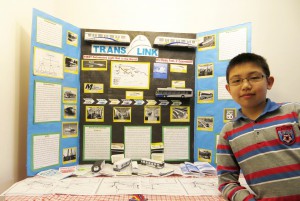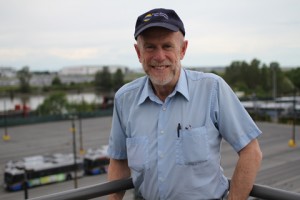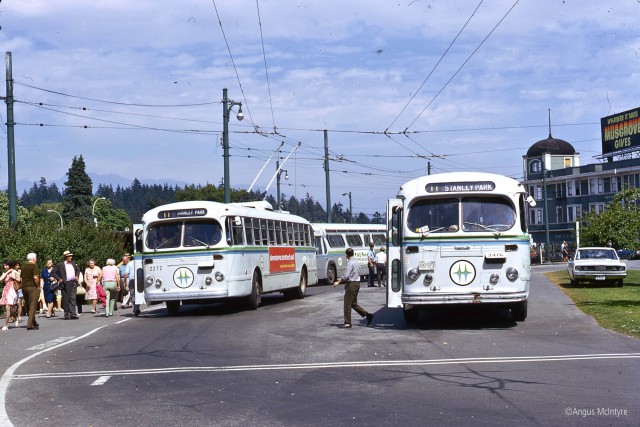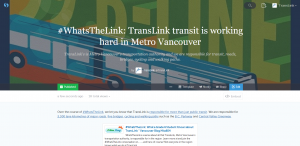#WhatsTheLink: TransLink transit is working hard in Metro Vancouver
#WhatsTheLink: TransLink transit is working hard in Metro Vancouver

We’ve let you know TransLink is responsible for much more than just transit — our mandate includes roads, bridges, cycling and walking paths.
But for #WhatsTheLink this week, we’re going to what we’re famous for — transit! We shared with you a number of Metro Vancouver transit photos from yesteryear and introduced you to our transit superheroes, the 99 B-Line, SeaBus, and SkyTrain.
How are they transit superheroes? The 99 B-Line is one of the busiest bus routes in North America, with nearly 17 million boardings in 2012. The SeaBus moves six million people each year across the Burrard Inlet between Downtown Vancouver and Lonsdale Quay in North Vancouver. And SkyTrain? It’s on-time 95 per cent of the time!
Miss 604: What a Grade 6 Student Knows About TransLink

Boya Yang is a grade six student at Marlborough Elementary in Burnaby and he knows TransLink’s transit system is hard working, helping to keep Metro Vancouver moving and livable.
He used TransLink as the subject of his project, which won him the Rotary Club of Burnaby Ambassador Award at the Rivers to Sea Regional Heritage Fair a couple of weeks back.
» Click here to see a picture of Boya’s project
Boya’s knowledge about TransLink is quite impressive! In his project, he highlights TransLink’s history and its importance as well as the different transit services TransLink offers including buses, SeaBus, SkyTrain, and West Coast Express.
As he points out in his project, TransLink helps connect people and make the region a better place to live.
To do this, TransLink connects the 418,000 people who take transit each day with a reliable system that is multimodal and seamlessly connected.
Vancity Buzz: Your hard working transportation system

How reliable? Well, here are a few facts from 2013:
- The SkyTrain is on time 95% of the time for both the Expo and Millennium lines.
- The West Coast Express is on time 98% of the time.
- TransLink delivered 99.4% of scheduled service for bus and SkyTrain last year.
Angus McIntyre retired in 2011 after over 40 years as a bus operator in Metro Vancouver.
During his years as a bus operator, Angus has seen a lot of changes to the system. These changes include the buses he operated and people he served.
As you can see from the photo below, he was a bit of a shutterbug and things looked a little different in the 70s and 80s.

Storify: TransLink transit is working hard in Metro Vancouver

What hasn’t changed since Angus’ time is a commitment by TransLink to move people and goods across the region.
TransLink has been providing transportation options to people in Metro Vancouver since 1999. For 15 years we’ve been part of your communities, getting you where you need to be.
Check out our Storify to see more of Angus’s photos and others, as well as on Facebook, Twitter, and Instagram! We’ve also launched a #WhatsTheLink microsite at http://www.translink.ca/wtl.
Author: Allen Tung






For those wondering, that picture by Angus is at Chilco Loop facing north with Lost Lagoon to the left. The bus at the back without trolley poles is probably the old 52 route that used to go around the park and serve the upper zoo loop, also ferrying passengers between Chilco and the current loop.
Accessing the loop required a notorious left turn across 3 lanes of Georgia Street with no traffic light. Although a plan was proposed to eliminate the left turn in 1970s, it wasn’t until the 1990s that a solution was implemented after drivers began refusing to make the turn.
The solution was to run the buses underneath the causeway, but there wasn’t enough room for the trolley poles required by the 19. A series of Burnaby routes (23, 123, 35, 135, 136) were extended to downtown Vancouver and into Stanley Park’s Upper Zoo loop to replace the 19 on weekdays. On weekends, the 19 was run with wheelchair accessible diesels.
When construction to heighten the underpass and install trolley wires was complete, Chilco Loop finally shut down and trolley buses could go all the way into the park.
I remember the controversy try to choose whether trolley lines should be allowed into the park vs allowing diesel fumes. Having the buses drop you off next to the railway is much easier than the long walk for children from Chilco.
From what I remember I don’t think the 52 went onto Pipeline or near the railway. It dropped you off at Lumberman’s Arch or had to walk in from the seawall stops. It’s amazing how the park keeps changing.
I also remember when you could drive 60km/h around the seawall, but the speeds were reduced because too many drivers were missing the turns and ended up in the water. It was a popular option to avoid the Lion’s Gate causeway congestion.